
|
Ferns
First posted June 26, 2004 Last
updated August 1, 2004

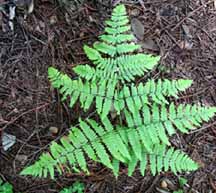 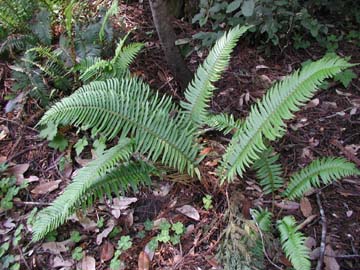
There are seven species of ferns in the
Cazadero region. Two are easily seen at camp:
bracken ferns (above, left) and sword ferns
(above, right). Three others can be found if you know
where to look: goldenback ferns, five-finger fern, and
woodwardia (chain) ferns. The final two, California
polypody and Maidenhair, are in the Cazadero region
but we have not yet found them in camp. (If you want
to know more about ferns and their allies, the horsetails,
in relation to other land plants, see Land
Plants.)

Introduction
|
"Ferns make up one of the
most popular groups of plants, exhibiting a tremendous
variety of forms, shapes and unique life cycles.
Approximately 11,000 species of true ferns have
been classified (in comparison with the more than
325,000 species of seed-bearing plants)."
(Michael Wood & Jake Sigg, Ferns of San Francisco)
Ferns are land plants with a vascular system
(mosses and their allies do not have a vascular
system*). Ferns do not produce seeds (like conifers)
or flowers (like the flowering plants). They reproduce
asexually by spores, which are borne in sori (seen
in photograph at right, and enlarged, below) on
the undersurface of mature leaves. They have a
very complex life
cycle, with an alternating gametophyte
generation and a sporophyte generation; the fern
that we are used to seeing is the sporophyte generation.
*As we saw in the
section on Land
Plants, the vascular system is an
internal circulatory system of specialized tissues
grouped as bundles in the roots, stems, and leaves
of the plant. One of these specialized tissues
is called the xylem, which transports water from
the roots to the leaves, while the other, the
phloem, transports nutrients and hormones within
the plant.
|
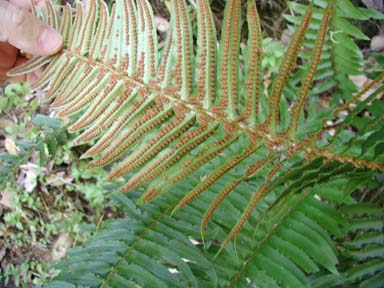
Sori are the golden-colored dots
on the underside of this sword fern leaf, taken
at Camp on June 22, 2004. They are seen enlarged
below.
|
Structure of a Fern
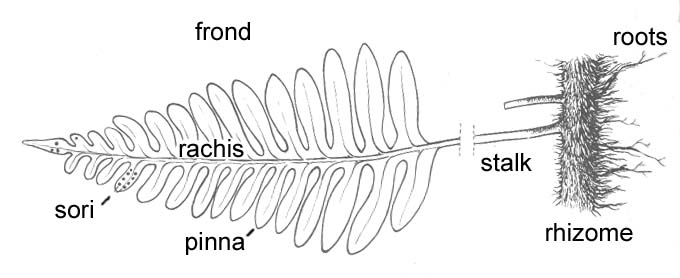 |
| Spore-producing ferns (the one we usually see)
are asexual and consist of an underground rootstalk
called a rhizome, from which arise the roots.
The rhizomes spread underground, growing continually.
They send up the parts of the fern that we normally
see. The stalk (stem) is the upright support for
the fern, from which come fronds. We might think
of these as the leaves, but they are different
in structure from the leaf of a flowering plant.
The fronds often consist of leaflets referred
to as pinna (plural is pinnae). They
arise from the rachis. The frond can be as above,
and is called pinnately compound (sword fern,
California polypody). If the frond has smaller
rachae coming off it, with the pinnae directly
attached to this secondary rachis, they are called
twice pinnately compound (bracken fern, woodwardia
fern). For another example, see this print. |
Spores
Spores are fascinating. They are
single cells that are very resistant to drying
out. A spore is similar to a seed, in that it
is structure used for propagation designed to
withstand drying out. It is different in that
a seed is an embryo (small version of the adult
organism) that is multicellular and has stored
food for the nourishment of the embryo. The
spore is not a miniature fern waiting to sprout,
but a plant part that has only half the full
complement of chromosomes that will grow into
another life form called a gametophyte, which
will ultimately generate the sperm and egg that
will unite to form a diploid (normal number
of chromosomes) fern. The spores are contained
in sporangia, which are grouped together into
sore. You can see the sori at the right, on
the undersurface of the fronds. For more details,
see life
cycle of a fern.
|
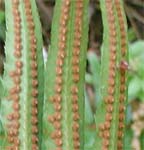 |
|
Fern fronds grow out from the
base in the curled shape as shown at right.
Can you guess what it is called?
A fiddleneck, and you can
see why, compared to a sideview of the neck
of a violin (fiddle is just a nickname for a
violin, it is the same instrument; the music
is different, not the instrument). |
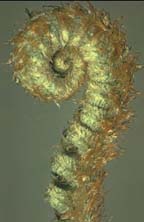
A new fern frond
grows out as a curled growth called a fiddleneck. |
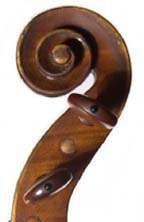
A violin neck,
as seen from the side, in a photograph by Vincent
Oliver. |
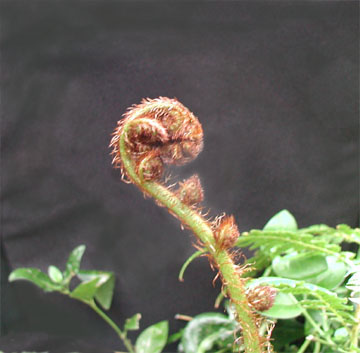
Fiddleneck unfurling into a new frond
Photo by David Nelson, July 23, 2004,
in Marin

Ferns of Cazadero

Sword Fern Polystichum
munitum
The most common fern you will see at Camp is
the sword fern, also called the western sword
fern. It is very widely distributed, found in
every county in California that borders the coast,
from northern border to the southern border of
the state, and in many inland counties. It is
so common within the redwood forest, it has been
said that if there is a tree overhead, there is
a sword fern underfoot. It has a simply pinnated
leaf, which means the pinnae come off the central
stem of the frond. Compare this to the bracken
fern, below. It is about 2 to 4 feet in height.
It is very easy to grow, making it ideal for
ornamental gardens, if you want to put a bit of
Caz in your life. They can be purchased at many
commercial nurseries.
|

Sword fern is
common throughout Camp.
(photographed at Caz on June 22, 2004) |

| Bracken
Fern
Pteridium aquilinum
Bracken ferns can be seen where it is just
a bit dryer than the areas that support sword
ferns. They can be seen just above Austin Creek
Road, the road above Camp. A separate page is
devoted to the bracken
fern. It has a double compound
leaf, which means that each frond stem has a
second stem branching off of it, to which the
pinnae are attached. |
 Bracken fern at Cazadero
Bracken fern at Cazadero |

Goldenback Fern
Pityrogramma triangularis
This is a delicate, 1 to 4 inch
tall fern that grows in moist, shaded, and protected
places. The fronds explain its species name
quite easily.
It might look superficially like
a bracken fern in a photograph, but it is quite
different in the forest. Besides its diminutive
size, its fronds are simpy pinnate at the tip,
but are secondarily pinnate at the base. The
most distinguishing feature, however, is the
back of the frond: it is a beautiful golden
color (see next section).
|
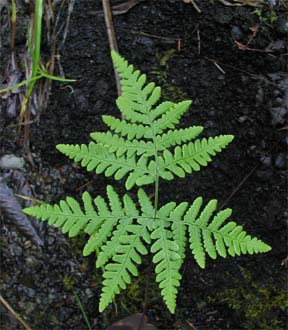
A goldenback
fern, photographed April 24, 2004, in the shade
of an old redwood log, just downstream of the
baseball diamond. |
| Although the fern is quite green on
the upper side, the undersurface of the frond is
quite pale, almost white, early in the year, turning
a more brown shade later, and finally, as the sori
mature, turns quite golden, as you can see here
(photo from California Biota, by Luis A. Solorzano
and Warren E. Savary). The beauty of this fern is
well worth the effort to search it out. |
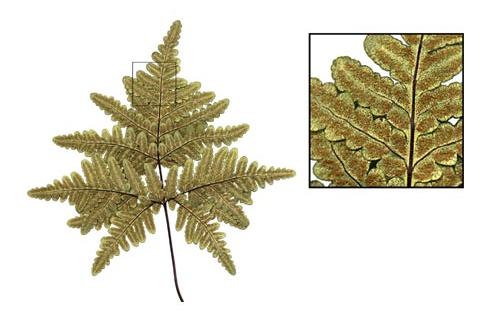 |
|
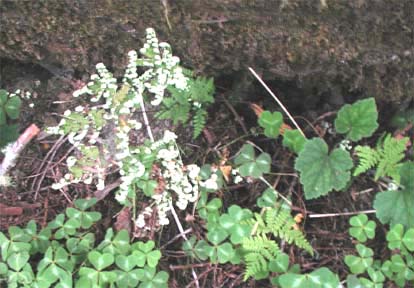 |
| Goldenback ferns dry out early in
the summer, as can be seen above. These photographs
were taken on April 24, 2004 (left) and on June
20, 2004 (right). The right photo was taken just
a bit to the right of the left one. On the later
photograph, the large goldenback fern on the left
has begun to dry out and curl, while the smaller
ones to the right are still green. |

California Polypody
Polypodium californicum
This 6 inch fern can grow on almost
anything as long as it is vertical: rotting logs,
rock faces, even on the bark of living trees.
It often grows in large colonies (see photo at
right), and tolerates more sun than most of our
ferns. Note the simple leaf structure (pinnately
compound), as opposed to the bracken and goldenback
ferns. One of its distinguishing features is the
rounded tip of the pinna, which can be seen below.
It derives its name from the Greek words polys,
meaning many, and podi, meaning foot,
because of the many knobby branches of the rhizome.
It is in the Caz region in many
sheltered creeks, but is not now known to be in
Camp itself.
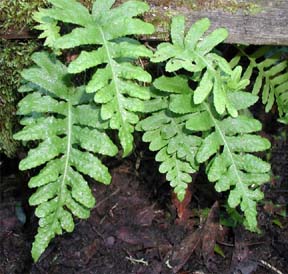
This group of polypody was photographed
Jan 19, 2004, in Muir Woods. |
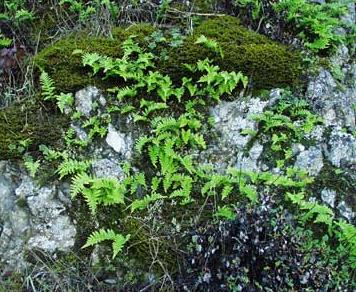
Polypody growing
on a steep rockface. |

Western Chain Fern
Woodwardia fimbriata
This is our largest fern, easily growing to 6
feet and can be as tall as 9 feet in ideal environments.
It can be found along the Austin Creek Road, in
among some bracken ferns, just upstream of camp.
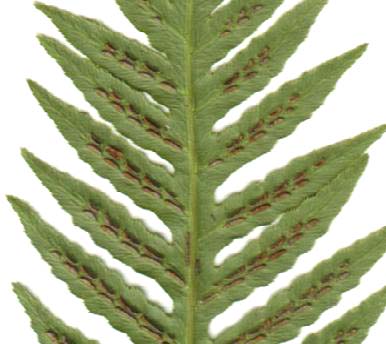
The name comes from the elongated
sori, which are arranged in two rows, along each
side of the midrib, that look like a chain (photo
by Sue Mandeville). |
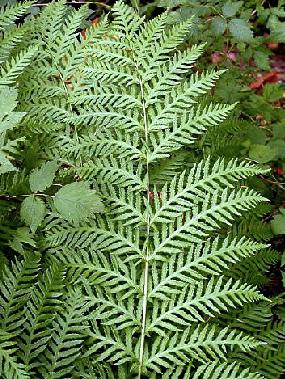
Western chain
fern, photograpy by John Dove. |

Five-Finger Fern
Adiantum pedatum
The delicate five-finger fern grows usually to
about 6 inches, although 10 inch specimens can
be found. It grows on heavily shaded steep walls
of creeks or seeps. This is a five-fingered fern,
photographed in the creek below CazSonoma
Inn, which is located downstream
from Camp, on Kidd Creek, a little tributary of
Austin Creek, on June 24, 2004.
Five-finger ferns are rare in camp, found so
far only in one place along Austin Creek and in
one tributary. Look on the main camp side of the
creek, about half-way upstream from the footbridge
to the entrance of the small creek at the upstream
end of Camp. You can also find one group up this
creek, on the downhill side, about 25 feet from
Austin Creek at summer level. Please: don't pick
or hurt these, or we will lose our only specimens. |
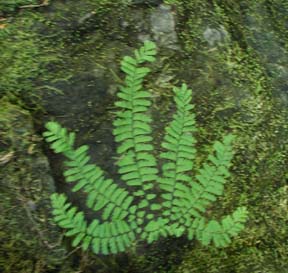 |
Maidenhair
Fern
Adiantum capillus-veneris
The delicate maidenhair fern is somewhat similar
in habitat, size, and growth form as the five-finger
fern. It grows usually to about 10 inches, although
18 inch specimens can be found. It grows on heavily
shaded steep walls of creeks or seeps.
We have not yet found it in camp, but it is normally
found in redwood forests along streams or creeks.
We will keep looking!
See the CalFlora
listing.
|
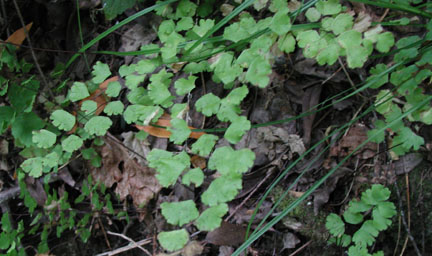
This maidenhair fern was photographed
in Samuel P. Taylor State Park, which is located
in a redwood forest in Marin County, on the was
out to Point Reyes. Photograph by David Nelson,
August 1, 2004. |

References
The San
Francisco State Department of Geology has
a great section on sword ferns.
The USGS
has a section on ferns and their allies,
with good photographs.
The American
Fern Society has a website.

Acknowledgments
The material above was based on Plants of the Coast
Redwood Region, by Lyons and Cuneo-Lazaneo. Additional
material is based on the San Francisco State Department
of Geology has a great section on sword ferns. The first
two sentences of the Introduction are by Michael
Wood & Jake Sigg, and are from their webpage,
part of the Yerba Buena (San Francisco) chapter of the
California Native Plant Society.
The sword fern fiddleneck is used with permission and
was taken by Charles
Webber; it is © California Academy of Sciences.
The violin fiddleneck is from the instructional
manual for PaintshopPro. The illustration of the parts
of a fern are from my old nature reference, Sierra Nevada
Natural History, published in 1966! It is by Storer
and Usinger. I used this book when I was a nature counselor
at the San Jose Family Camp, in 1969-72, where I was
christened with my camp name, Bugs, that I still use
at Caz. The goldenback fern underside is from California
Biota,
by Luis A. Solorzano and Warren E. Savary. The California
Polypody is from the Mostly
Natives Nursery, in Marin; the sori of
the polypody is from the Marin
Chapter of the California Native Plants
Society. The woodwardia sori are by Sue Mandeville,
from the Hardy
Fern Foundation; the frond was from the
Pacific Rim Native Plant Nursery and is
by John Dove.


|

|

